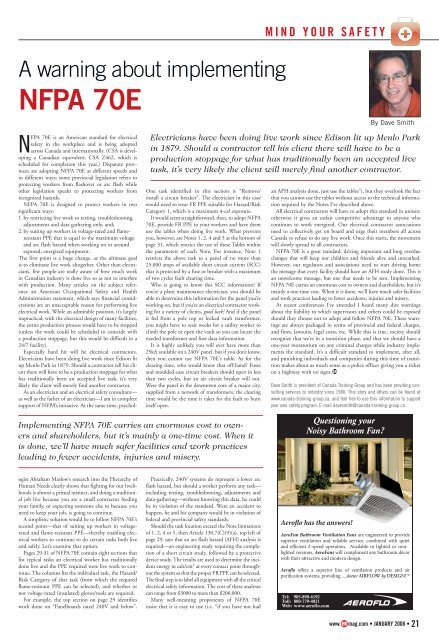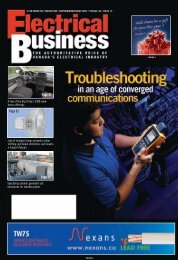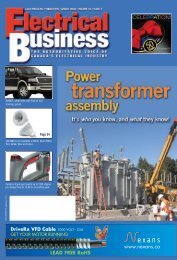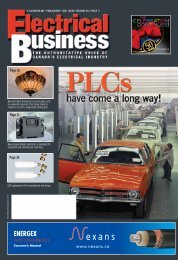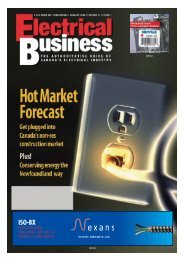vincial director of training, <strong>Electrical</strong> Industry Education TrustFund of Alberta, discussed how his outfit, despite having threebrick-and-mortar facilities, invested in video conferencing “sowe can broadcast from one location to another”. The technologyis not perfect, though, as Matthews admits there are some speedissues, but they “mainly use it for meetings so we don’t have to flypeople back and forth”. Matthews’ group also successfully tackledthe issue of off-site training by investing about $1 million ina trailer that can visit folks in work camps.Rick Lousier, Local 2085’s training and education coordinatorin Manitoba, had some sobering concerns in his part of theworld. “We have trouble getting people out for training,” headmits, “because they’re just so busy, and with the AboriginalOutreach Program, we didn’t have the mentoring program wewere assured we would have.” At the same time, Lousier concedes,there’s no point in having a training program “if you don’thave any jobs for them... you just become a broken promise”.Fern Tardiff, chair of Local 625’s JATC in Nova Scotia,explained his group tracks apprentices’ training to make surethey’re getting good exposure. And they listen to their contractors.“[They] were telling us they were getting too many apprenticeswho have never set foot on a construction site [so now]the apprentices need a pre-apprenticeship period to gain somepractical experience.”IndustryAnnouncementSt. Thomas Holding Inc., wholly owned by theCity of St. Thomas, and the owner and operatorof St. Thomas Energy Services Inc. (STESI), hasentered into an agreement to purchase the sharesof two companies near the Town of Tillsonburg:Tiltran Services and Lizco Sales. This is thefirst transaction of its size in Ontario involving amunicipally-owned utility company purchasing acompetitive, privately-owned services company.Tiltran specializes in the engineering, constructionand maintenance of high voltage electrical power,wind and solar systems. Lizco has the largest,privately-owned transformer inventory in Canada.Together, the companies will have the abilityto gain access to broader markets and largerprojects, find ways to secure new revenuestreams and be aggressive in pursuing newbusiness opportunities. The transaction will becompleted on January 2, 2008.St. Thomas Energy Services Inc. along with theirnew partners Tiltran and Lizco will continue toprovide excellence in service to their customersin Ontario, Canada and North America.For more information, please contact BrianHollywood, President and CEO, St. ThomasEnergy Services Inc. at 519.631.4211 ext. 238,www.stesi.com or Pat Carroll, President,Tiltran Services at 519.842.6458 ext. 225,www.tiltran.com.In this session, led by Carol MacLeod, participants learned how todeliver NETCO’s curriculum on Test-Taking Strategies for Red Seal<strong>Electrical</strong> Exams and options for integrating it into ongoing technicaltraining programs. MacLeod is NETCO’s project consultantand the designer of NETCO’s Test-Taking Strategies curriculum.And all this happened Saturday morning before breakingfor lunch! There was more to come.Saturday afternoonAfter lunch, registrants attended one of three afternoon seminars:1) Construction Sector Council Workshop on PlainLanguage; 2) Interview Techniques for Selecting Apprentices;and 3) Train-the-Trainer: Test-Taking Strategies for Red Seal<strong>Electrical</strong> Exams.For my part, I tried popping in and out of sessions to geta feel for all of them. One of the highlights of Session 3 wasmeeting CSA’s Bob Nelson, the mastermind behind an interactiveCD that helps you train for your C of Q. Known asESAT (Electrician’s Self-Assessment Tool), it helps you getthrough the pressure of preparing for the final C of Q examby putting you through the paces with more than 1100sample questions covering each block, task and subtask inthe HRSDC Occupational Analysis for the ConstructionElectrician. Available for purchase on CSA’s website (www.csa.ca), the CD is based on CE Code 2006–Part I to matchcurrent exam coverage.In Seminar 1, Julia Lew (a workplace educator for SkillPlan),walked her group through a number of examples of excessivelywordy and confusing messages, and showed them how to cleanup the text so that the message comes through loud and clear.After all, in many industries—especially construction—youwant everyone to understand policies, warning, dangers, etc.perfectly. At the start of her session, she explained three Tips toconsider before committing a message to paper: 1) Organizethe information; 2) Make it short; and 3) Be clear.Finally, Session 2’s Cheryl Crumb explained the nuances ofinterviewing, particularly as it relates to interviewing a potentialapprentice candidate, or apprentice for your company.(However, these techniques can apply to anyone, anywhere).Like onions, people have many layers, and Crumb identifiedthe three layers with which interviewers should be concerned.Level 1 just scratches the surface; our gut reaction to a person.It’s superficial and what Crumb calls “dating behaviour”.When you get down to Level 2 of a person, that’s where youlearn about their credentials; their technical abilities. However,this is already on the person’s resume, so why waste time withthat at the interview?No, Crumb suggests we must drill down to the final layer,Level 3, of a person, to learn about their attitude and job beliefs,as this is the level that ultimately decides what kind of personwe’re bringing on board, and whether or not we’ll be happywith them. “We must learn to ask Level 3 questions from theoutset,” Crumb says, arguing that we shouldn’t place muchimportance on resumes. “They serve to list the basic thingsthe candidate must have. Beyond that, they tell you nothing ofthe individual [and] let’s face it: an electrical apprentice won’tconsider resume-writing an Essential Skill.” She summarizes:“Our challenge is to ask the questions that reveal behaviours”.Sunday morningThe NETCO Symposium didn’t fool around with ourtime, as Sunday morning again featured a line-up of prominentspeakers.Sandie Birkhead-Kirk of the CCDA (Canadian Council ofDirectors of Apprenticeship) talked about her organizationIn the photo are (left to right): CECA’s executive secretary, ErylRoberts; Scott Murray, ex-StatsCan statistician, now presidentof DataAngel Policy Research Inc.; and Jerry Wilson, IBEW (FirstDistrict, Canada) international representative. Murray’s presentation“Human Capital Development: Key Issues and ChallengesFacing the Construction Industry” was somewhat bleak, to saythe least, but they say that knowledge is power, so in that regardhe did a great job of preparing us for the world to come.and how it fits into the Canadian skilled labour landscape.This is the group behind the whole Red Seal program, andone of things she admitted was that CCDA recognizes thatit needs “more input and transparency” with the examinationprocess. However, CCDA is moving forward. In 2005,explained Birkhead-Kirk, it adopted a change in its mandateto include research.So, some time this year, we should expect the completionof the National Apprentice Survey (NAS). Some other projectsthat should be complete (or near completion) includeApprenticeship Technical Training Models and the 1993Registered Apprentices Cohort Study (we’ll keep you posted).There was one more presentation that really bears examination:“Human Capital Development: Key Issues andChallenges Facing the Construction Industry” by ScottMurray (an ex-StatsCan numbers-cruncher, now presidentof DataAngel Policy Research Inc.). This presentation reallyopened many of our eyes to the past, current and futurestate of both skilled trades and Canadians’ employabilityon the global scene. Something Murray referred to as ‘TheUndeclared War’—that is, on our livelihoods and the standardof living we enjoy in Canada.Murray argued, and says the numbers prove him out, thatthe skilled trades create greater wealth for a society “than rocketscientists”. But the real purpose behind his talk was to explainhow the world is changing, and that if we don’t adapt quickly,“we’re in deep shit”. One of the problems in Canada is that“we’re not having enough babies”; not enough kids are comingthrough the education system to fill market requirements forskilled labour. Our second problem (opportunity) is globalizationof goods and services. “For the firms that can muster thethings that they need to compete internationally, this offershuge opportunity, huge economies of scale,” he said, withouthaving to say what would happen to the firm that cannot musterin the face of globalization.The market for all of the key inputs has also globalized, sono matter where you’re located, everyone is gaining the sameaccess to technology, capital, etc. So all things being equal,argued Murray, your success will come from your people.Another problem that Murray threw into the mix is the factthat “multinationals are willing and able (even overnight)” tomove their operations to the lowest-cost regions of the world.As such, job losses are inevitable in Canada. However, whatremains to be seen—and it becomes a matter of public policy,says Murray—is whether laid-off Canadians will be able tofind similar, well-paying replacement jobs.“The ringer in this ‘undeclared war’ is that other countriesare gaining ground in education and training,” said Murray,explaining that when people in Bangladesh, for example,achieve the same levels of skill and education as their Canadiancounterparts—and possess the same access to informationtechnologies—they’ll be able to compete directly against uson costs alone. In essence, Canada won’t stand a chance. Prettydoom and gloom.Suffice to say, the NETCO Symposium really drove homethe idea of how much we all need to pool our resources toensure the success of all. Unless we all work toward the commongoal of being the best in the world (that’s right... not justCanada, but the world), we may have to start practising tellingpeople what it’s like not to live in a First World country.20 • january 2008 • www. mag.comStThomas_EB_Nov07.indd 111/23/07 12:51:03 PM
Mind your safetyA warning about implementingNFPA 70EBy Dave SmithElectricians have been doing live work since Edison lit up Menlo Parkin 1879. Should a contractor tell his client there will have to be aproduction stoppage for what has traditionally been an accepted livetask, it’s very likely the client will merely find another contractor.One task identified in this section is “Remove/install a circuit breaker”. The electrician in this casewould need to wear FR PPE suitable for Hazard/RiskCategory 1, which is a maximum 4-cal exposure.It would seem straightforward, then, to adopt NFPA70E, provide FR PPE to your workers and have themuse the tables when doing live work. What preventsyou, however, are Notes 1, 2, 4 and 5 at the bottom ofpage 31, which restrict the use of these Tables withinthe parameters of each Note. For instance, Note 1restricts the above task to a panel of no more than25,000 amps of available short circuit current (SCC)that is protected by a fuse or breaker with a maximumof two cycles fault clearing time.Who is going to know this SCC information? Ifyou’re a plant maintenance electrician, you should beable to determine this information for the panel you’reworking on, but if you’re an electrical contractor workingfor a variety of clients, good luck! And if the panelis fed from a pole top or locked vault transformer,you might have to wait weeks for a utility worker toclimb the pole or open the vault so you can locate theneeded transformer and fuse data information.It is highly unlikely you will ever have more than25kA available on a 240V panel, but if you don’t know,then you cannot use NFPA 70E’s table. As for theclearing time, who would know that off-hand? Fusesand moulded-case circuit breakers should open in lessthan two cycles, but an air circuit breaker will not.Were the panel in the downtown core of a major city,supplied from a network of transformers, the clearingtime would be the time it takes for the fault to burnitself open.an AFH analysis done, just use the tables”), but they overlook the factthat you cannot use the tables without access to the technical informationrequired by the Notes I’ve described above.All electrical contractors will have to adopt this standard in unison;otherwise it gives an unfair competitive advantage to anyone whocontinues to work energized. Our electrical contractor associationsneed to collectively get on board and urge their members all acrossCanada to refuse to do any live work. Once this starts, the movementwill slowly spread to all contractors.NFPA 70E is a great standard, driving important and long overduechanges that will keep our children and friends alive and unscathed.However, our regulators and associations need to start driving homethe message that every facility should have an AFH study done. This isan unwelcome message, but one that needs to be sent. ImplementingNFPA 70E carries an enormous cost to owners and shareholders, but it’smainly a one-time cost. When it is done, we’ll have much safer facilitiesand work practices leading to fewer accidents, injuries and misery.At recent conferences I’ve attended I heard many dire warningsabout the liability to which supervisors and others could be exposedshould they choose not to adopt and follow NFPA 70E. These warningsare always packaged in terms of provincial and federal charges,and fines, lawsuits, legal costs, etc. While this is true, society shouldrecognize that we’re in a transition phase, and that we should have aone-year moratorium on any criminal charges while industry implementsthe standard. It’s a difficult standard to implement, after all,and punishing individuals and companies during this time of transitionmakes about as much sense as a police officer giving you a ticketon a highway with no signs.Dave Smith is president of Canada Training Group and has been providing consultingservices to industry since 1980. This story and others can be found atwww.canada-training-group.ca, and feel free to use this information to supportyour own safety program. E-mail davesmith@canada-training-group.ca.Implementing NFPA 70E carries an enormous cost to ownersand shareholders, but it’s mainly a one-time cost. When itis done, we’ll have much safer facilities and work practicesleading to fewer accidents, injuries and misery.Questioning yourNoisy Bathroom Fan?NFPA 70E is an American standard for electricalsafety in the workplace and is being adoptedacross Canada and internationally. (CSA is developinga Canadian equivalent, CSA Z462, which isscheduled for completion this year.) Disparate provincesare adopting NFPA 70E at different speeds andin different ways; some provincial legislation refers toprotecting workers from flashover or arc flash whileother legislation speaks to protecting workers fromrecognized hazards.NFPA 70E is designed to protect workers in twosignificant ways:1. by restricting live work to testing, troubleshooting,adjustments and data gathering only, and;2. by suiting up workers in voltage-rated and flameresistantPPE that is equal to the maximum voltageand arc flash hazard when working on or aroundexposed, energized equipment.The first point is a huge change, as the ultimate goalis to eliminate live work altogether. Other than electricians,few people are really aware of how much workin Canadian industry is done live so as not to interferewith production. Many articles on the subject referencean American Occupational Safety and HealthAdministration statement, which says financial considerationsare an unacceptable reason for performing liveelectrical work. While an admirable position, it’s largelyimpractical; with the electrical design of many facilities,the entire production process would have to be stopped(unless the work could be scheduled to coincide witha production stoppage, but this would be difficult in a24/7 facility).Especially hard hit will be electrical contractors.Electricians have been doing live work since Edison litup Menlo Park in 1879. Should a contractor tell his clientthere will have to be a production stoppage for whathas traditionally been an accepted live task, it’s verylikely the client will merely find another contractor.As an electrician and an electrical safety consultant—as well as the father of an electrician—I am in completesupport of NFPA’s initiative. At the same time, psychologistAbraham Maslow’s research into the Hierarchy ofHuman Needs clearly shows that fighting for our livelihoodsis almost a primal instinct, and doing a traditionaljob live because you are a small contractor feedingyour family, or expecting someone else to because youneed to keep your job, is going to continue.A simplistic solution would be to follow NFPA 70E’ssecond point—that of suiting up workers in voltageratedand flame-resistant PPE—thereby enabling electricalworkers to continue to do certain tasks both liveand safely. Let’s examine that option.Pages 29-31 of NFPA 70E contain eight sections thatlist typical tasks an electrical worker has traditionallydone live and the PPE required were live work to continue.The columns list the individual task, the Hazard/Risk Category of that task (from which the requiredflame-resistant PPE can be selected), and whether ornot voltage-rated (insulated) gloves/tools are required.For example, the top section on page 29 identifieswork done on “Panelboards rated 240V and below”.Practically, 240V systems do represent a lower arcflash hazard, but should a worker perform any task—including testing, troubleshooting, adjustments anddata-gathering—without knowing this data, he couldbe in violation of the standard. Were an accident tohappen, he and his company would be in violation offederal and provincial safety standards.Should the task location exceed the Note limitationsof 1, 2, 4 or 5, then Article 130.7(C)(9)(a), top left ofpage 29, says that an arc flash hazard (AFH) analysis isrequired—an engineering study requiring the completionof a short circuit study, followed by a protectivedevice study. The results are used to determine the incidentenergy in cals/cm 2 at every contact point throughoutthe system so that the proper FR PPE can be selected.The final step is to label all equipment with all the criticalelectrical safety information. The cost of these analysescan range from $3000 to more than $200,000.Many well-meaning proponents of NFPA 70Einsist that it is easy to use (i.e. “if you have not hadAeroflo has the answers!AeroFan Bathroom Ventilation Fans are engineered to providesuperior ventilation and reliable service, combined with quietand efficient 2-speed operation. Available in lighted or nonlightedversions, AeroFans will compliment any bathroom décorwith their attractive and modern design.Aeroflo offers a superior line of ventilation products and airpurification systems, providing .....better AIRFLOW by DESIGN! TMTel: 905-890-6192Toll: 800-779-4021Web: www.aeroflo.comAeroflo_EB_Nov07.indd 1www. mag.com • january 2008 • 2110/16/07 3:51:41 PM


